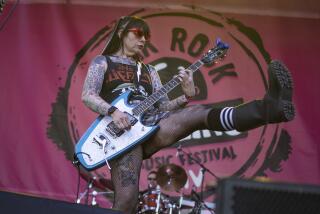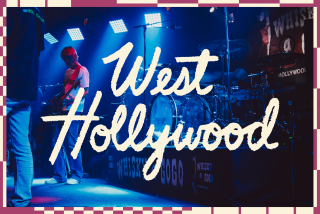The alternative revolution
- Share via
BY the late 1970s, most FM stations were indentured to formats designed by niche-obsessed consultants who’d shoved demographic-driven homogenization down listeners’ unsuspecting throats. Which was fine, if you wanted to hear Boston’s “More Than a Feeling” on the hour. But Blondie? The Clash? X? Forget about it. Only L.A.’s own renegade station KROQ dared play the revolutionary new sounds emanating from London, New York and Southern California with any regularity.
KROQ program director Darrell Wayne gave his on-air staff the freedom to mix the familiar — such as David Bowie — with the new. Weekend DJ Rodney Bingenheimer, in particular, pushed the sonic envelope, becoming one of America’s foremost punk-rock tastemakers.
At times, KROQ sounded like a multi-car pileup, which might be great for listeners but spelled suicide for station owners looking for a return on their investment. So in 1979, Top-40 programmer Rick Carroll was hired to restore order. He applied his tight, commercially proven formula to core artists such as the Ramones, Devo, Elvis Costello, Pretenders and Talking Heads. The DJs grumbled, but the format worked: Within a few short years, KROQ was the hottest station in town.
Carroll was hailed as a genius, and his “Roq of the ‘80s” format transformed radio stations nationwide. KROQ’s influence had become so great that when MTV launched in 1981, the nascent network looked to the hip L.A. station for its programming cues, and KROQ discoveries such as Duran Duran, Adam Ant and Billy Idol became mainstream superstars.
In 1986, station owner Ken Roberts sold the station to Infinity Broadcasting for a then-record sum of $45 million. In the two decades since, KROQ has successfully completed its transformation into a powerful brand, molding youth culture, making and breaking bands and developing such widely imitated events as the Weenie Roast, Acoustic Christmas and Inland Invasion.
Punk rock — and the alternative culture it spawned — is still breathing. But it’s been sliced, diced, puréed and flambéed for maximum financial return. In a culture of commercial cool — where every town in America is filled with tattooed Green Day-loving teens — KROQ is where it all began.
More to Read
The biggest entertainment stories
Get our big stories about Hollywood, film, television, music, arts, culture and more right in your inbox as soon as they publish.
You may occasionally receive promotional content from the Los Angeles Times.










